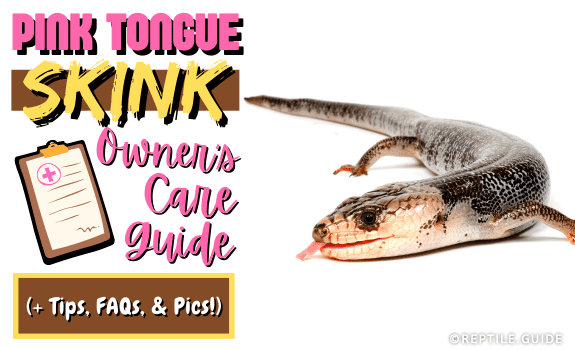The pink tongue skink, Cyclodomorphus gerrardii, is a large lizard with a docile temperament.
These animals come from the wilds of Australia, where they’re known as the pink-tongued lizard.
Pink-tongued skinks have a gentle temperament and are easy to keep. This makes them an ideal pet lizard for children, adults, beginners, and experts.
In This Article
Pink-Tongued Skink Background Information
Pink-tongued skinks are similar to the common blue-tongue skinks. Both come from Australia and have great temperaments. Let’s take a closer look.
Appearance and Size
Pink-tongued skinks are large animals that can reach lengths of up to 18 inches. The partially prehensile tail constitutes up to 50% of the animal’s overall length.
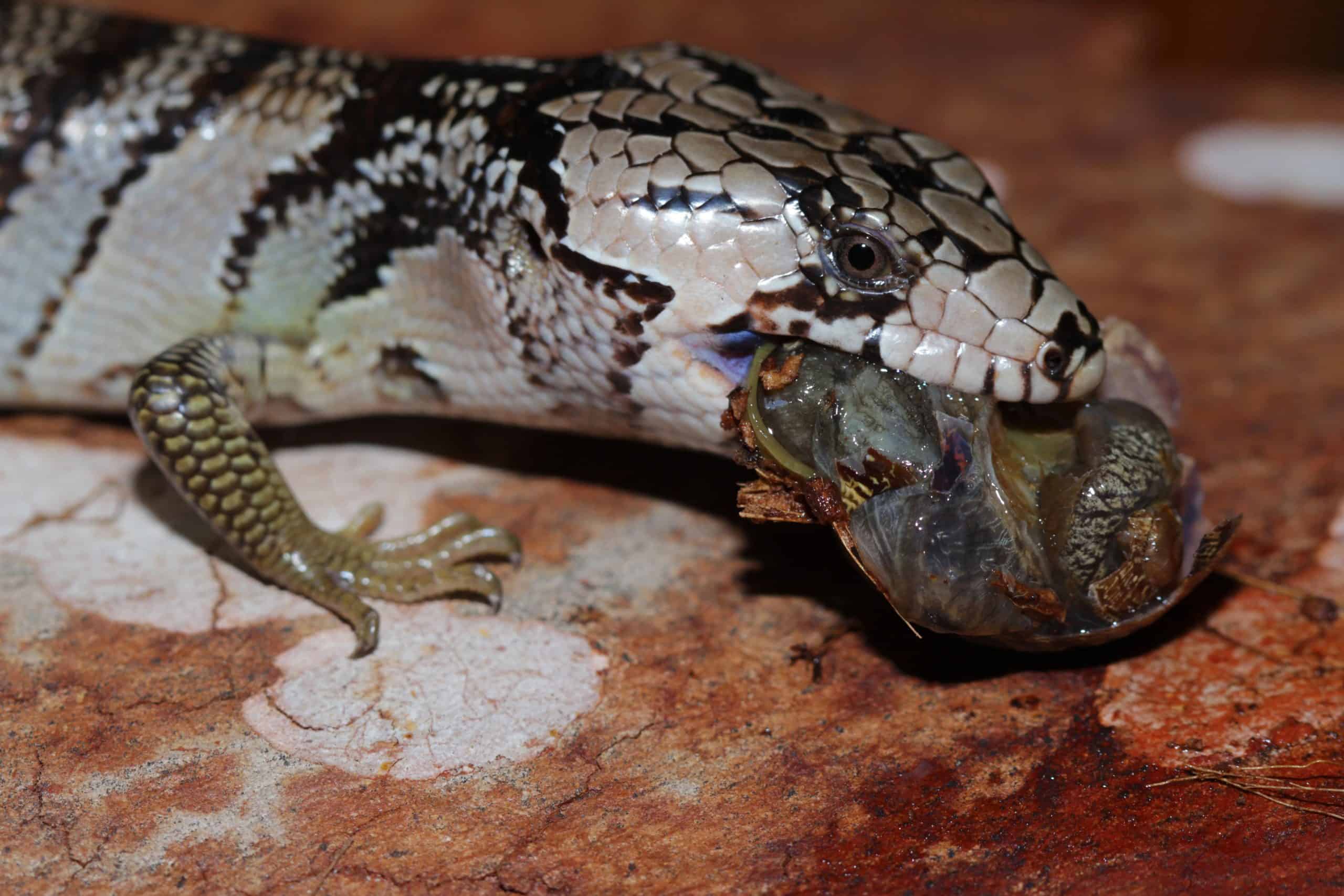
Image credit: u/cpmar111 (via Reddit.com)
Unlike some other skinks, these animals have noticeable necks. Males have wider, more pronounced heads than females.
Only adults have the bright pink tongues that give these animals their name.
Scientists are still trying to understand the colors of pink and blue-tongued skinks’ tongues, but young pink tongue skinks have black or blue tongues.
The pink tongue skinks have long toes with sharp claws. They use them to help them climb
This lizard has a slender body covered in alternating bands of silvery-gray and dark brown. Sometimes a pink-tongued skink may have a light brown color instead of gray.
Other individuals may be patternless. There’s a lot of variation within the species.
Natural Habitat
Pink-tongued skinks are endemic to Australia, where they inhabit regions with high humidity levels and lots of ambient moisture.
Their preferred habitats include:
- Rainforests
- Wet lowland forests
- Moist woodland areas
These animals live in dense undergrowth and like areas with long grass. They’re also semi-arboreal and use their semi-prehensile tail and sharp claws to climb.
Pink Tongue Skink Enclosure
The pink-tongued skink is a large animal that requires a correspondingly large enclosure.
An adult lizard will require at least a 10-gallon enclosure.
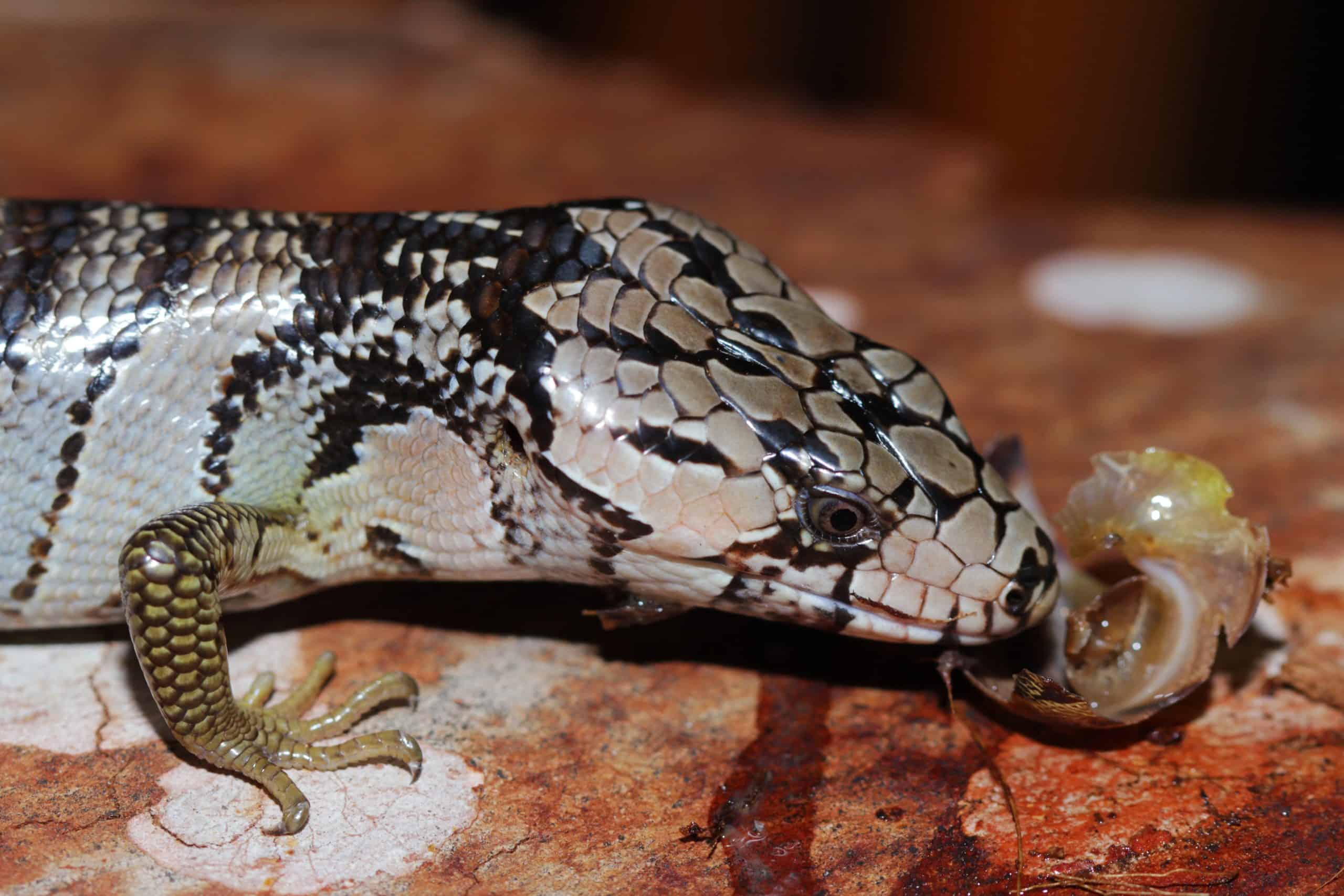
Image credit: u/cpmar111 (via Reddit.com)
However, these animals are active and will benefit from more space. We suggest aiming for at least a 20-gallon enclosure if you can.
Substrate
Pink-tongued skinks don’t have a lot of requirements when it comes to the substrate. There’s a variety of viable substrates that will work well for your skink.
The pink tongue skink likes to burrow, so the best substrates are soft and will allow your pet to burrow.
In their wild habitat, they spend a lot of time burrowing or hiding in leaf litter.
Some of the best substrates that will retain moisture while allowing your skink to burrow include:
- Coco Peat – Coco peat has a lot of advantages. It:
- It is a renewable resource.
- Absorbs and maintains moisture.
- Helps to keep humidity levels stable.
- Uses a byproduct of the coconut food industry.
- It is soft and malleable: ideal for burrowing animals.
- Peat Moss – Peat moss has many of the same advantages as coco peat. However, some disadvantages make coco peat preferable. The disadvantages are:
- It’s not a renewable resource.
- Almost all peat moss is harvested in the United Kingdom.
- Harvesting peat moss will soon be stopped by law to protect the peat bog habitat.
- Orchid Bark – Orchid bark has many advantages, including:
- It’s affordable.
- It absorbs moisture.
- It helps to maintain humidity.
The main disadvantage of orchid bark is that it’s not easy to burrow in. Not a desirable trait for a digging species like the pink-tongue skink.
- Cypress Mulch – Cypress mulch is a go-to substrate for many reptile species. Advantages include:
- It absorbs moisture.
- It helps to keep humidity constant.
- It’s soft and malleable: easy to burrow in.
- It’s easy and affordable to replace or clean.
- Aspen Shavings – Aspen shavings have many of the same advantages as cypress mulch. However, it’s not as good at maintaining humidity as cypress mulch is.
Since pink-tongued skinks have low humidity requirements, that’s not a problem.
Any one of these substrates will work well. If you’re looking for the easiest option, we suggest using cypress mulch.
If you’re looking for the best substrate for burrowing, we suggest using a combination of coco peat and orchid bark. You can also add sand for structural integrity.
Temperature and Humidity Pink-Tongued Skinks
As with most reptiles, the pink-tongue skink can’t moderate its body temperature internally.
If you want your pet pink-tongued skinks to thrive, you need to give them a temperature gradient.
This is easy to do if you only heat one-third of the enclosure. The following temperatures are the best for your pink-tongued skink:
- Cool Side: 20-25 °F
- Warm End: 33-35 °F
- Ambient Temperature: 25-30 °F
- Nighttime Temperature: 20 °F
The pink-tongued skink has a high humidity requirement. You need to try and maintain an ambient humidity of 60-70%.
It’s easy to maintain this level of humidity as long as you use an absorbent substrate. Using large water bowls is also helpful.
You can mist the substrate daily. Your absorbent substrate will absorb moisture, become warm, and release water vapor (humidity) into the air.
If you place the water bowl on the warm side of the enclosure, it will push more humidity into the enclosure.
If the humidity is too high, you can move the water bowl away from the heat or mist less.
In extremely dry areas, you may want to consider adding a reptile humidifier to your pink-tongued skink enclosure.
Heating and Lighting
There are many different options for heating your pink-tongued skink enclosure. Some of them include:
- Heat Cables – Heat cables work well for heating rack systems but aren’t ideal for individual enclosures.
They’re a simple heating element, which you can attach to the outside of the enclosure.
- Heat Lamps – Heat lamps are an excellent choice for the pink-tongued skink. These animals require relatively high temperatures, which many heat lamps can provide.
They produce light and heat, so they aren’t ideal for use at night.
- Ceramic Heat Emitters – Ceramic heat emitters are similar to a heat lamp but provide heat without creating light.
They’re an ideal choice for evening heating or use with a cool lighting system.
- Heating Mats and Pads – Under-tank heat pads are ideal for warming the enclosure at night or helping to maintain temperatures in a cool climate.
If you live in a cold area, we suggest using a heat lamp during the day and a heating pad or ceramic heat emitter at night.
As with most reptiles, the pink-tongued skink needs a day and night cycle to stay healthy.
Having permanent lighting or permanent darkness will confuse your skink’s biological clock. This kind of problem can lead to fatal disorders or illnesses.
The best light cycle for the pink-tongued skink is 12 hours with light and 12 hours without.
Lighting options are diverse and include:
- LED Lighting – LED lighting is the most effective lighting option for your pink-tongued skink.
LED bulbs have a longer lifespan, consume less energy, and don’t generate much heat.
- Halogen Lighting – Halogen lighting may seem cheap at first glance, but the bulbs need regular replacement.
You’ll need to replace the bulbs at least once every six months. Even if the bulbs still work, they’ll stop producing enough UV radiation after this time.
Halogen bulbs also get hot and can affect the enclosure temperature negatively.
- Fluorescent Lighting – Fluorescent lighting is somewhere between LED and Halogen.
It has a similar lifespan to halogen bulbs but consumes less energy. It generates more heat than LED but less than halogen.
Whichever option you choose, your pink-tongued skink will benefit from the addition of a UVB light.
UVB light helps your lizard to metabolize minerals and nutrients from its food. Without it, the skink may not metabolize calcium properly.
Evidence shows that UVB light also helps to bring out the colors of a reptile and may boost the immune system.
We suggest using a full-spectrum LED lighting system for your pink-tongued skink. Adding a UVB light as supplemental lighting will complete the lighting setup.
Hides and Decor
Your pink-tongued skink requires hides to feel free and safe in its enclosure. In the wild, they spend their time among leaf litter and in natural hollows where they find shelter.
We suggest using three hides for your skink:
- A humid hide
- One on the cool side
- One on the warm side
Having this arrangement of hides allows your pink-tongued skink to choose the hide that suits its temperature preference.
A humid hide is a box with a dense layer of moist substrate in the bottom. The moist substrate keeps the humidity high inside the box.
The hide should have a single entrance for your skink to enter the hide. The skink will use the box when shedding. The hide’s humidity will promote a problem-free shed.
Since these animals naturally live in the undergrowth, you might want to consider the addition of artificial plants. It will add an extra layer of security for your pet.
Of course, you can try to incorporate live plants, but the pink-tongued skink is large and heavy-bodied.
These animals often wreck planted enclosures with their tenacity for burrowing and climbing.
We won’t discourage you from a planted terrarium, but be sure to choose hardy plants that can take a beating.
Pink Tongue Skink Diet
In the wild, the pink-tongued skink eats a diet that consists predominantly of slugs and snails.
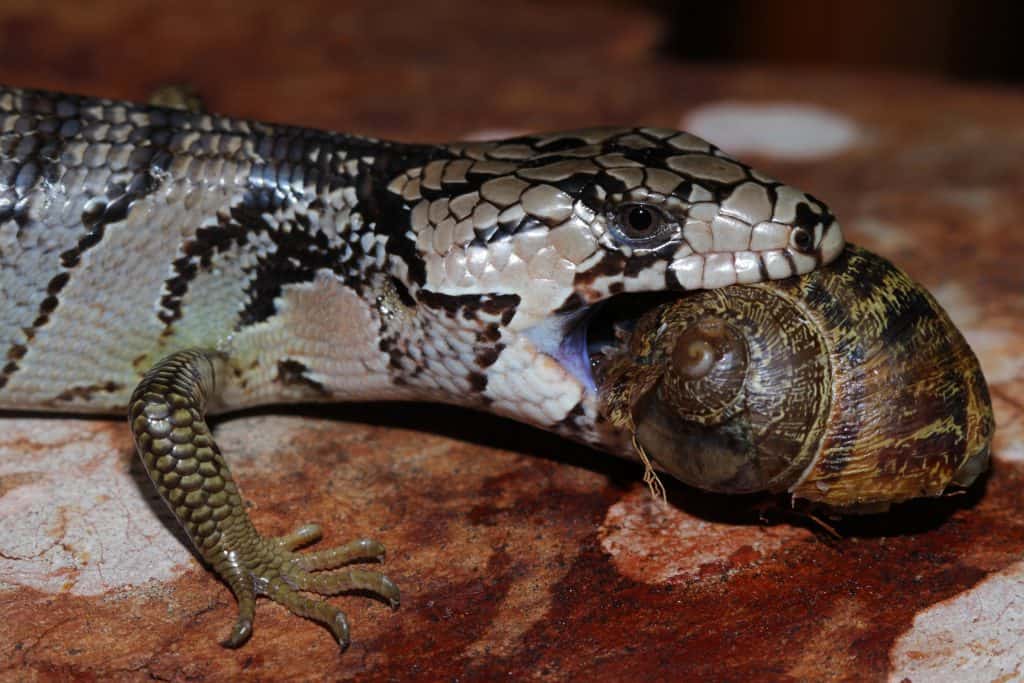
Image credit: u/cpmar111 (via Reddit.com)
While you can easily get snails in the pet trade, these animals will easily accept a varied diet.
Some of the feeding options in captivity include:
- Crickets
- Mealworms
- Superworms
- Canned Cat Food
- Wax Worms (as a treat)
- Black Soldier Fly Larvae
Try to provide as varied a diet as possible. Foods like waxworms are high in fat, and you should only use them as an occasional treat.
Crickets, super worms, and black soldier fly larvae make excellent staples, as they’re high in protein.
Try to add snails to your pink-tongued skink diet if possible, as they’ll appreciate the natural food source.
Some lizards may be picky and refuse to eat anything but snails or only accept other foods in small amounts.
You must plan ahead in case your pet refuses live foods other than snails. If your skink only eats snails, you need a consistent supply of them.
Ensure that you use a high-quality calcium supplement, so the lizard gets enough calcium in its diet.
Pink-Tongue Skink Price
The pink-tongued skink is an easy animal to breed. Each female produces up to 20 babies at a time.
However, it takes around two years for these animals to reach sexual maturity. As a result of the breeding ease and slow maturing of these animals, the price is intermediate.
You can expect to pay around $250 for a baby pink-tongue skink.
Where to Buy a Pink-Tongued Skink
There are many different places where you can buy pink-tongued skinks. These animals are popular and easy to breed, making them easy to find.
One of the best places to find these skinks is at your nearest reptile convention (Repticon) or reptile expo.
These events host breeders from around the country and put them through a detailed vetting process before accepting them.
You should find at least one breeder that sells skinks at a Repticon.
Other options include doing a Google search. Many reputable breeders sell these skinks online, and you’ll have no trouble finding one.
If you’re concerned about the reputation of a breeder, you can ask members of a reptile forum for their opinion or look on a review site.
Asking around on reptile forums may also lead you to skink breeders in your area. Fellow hobbyists will be happy to point you in the right direction.
Pink-Tongue Skink Morphs
Unlike some other skink species, like the blue-tongued skink, the pink-tongued skink doesn’t have morphs.
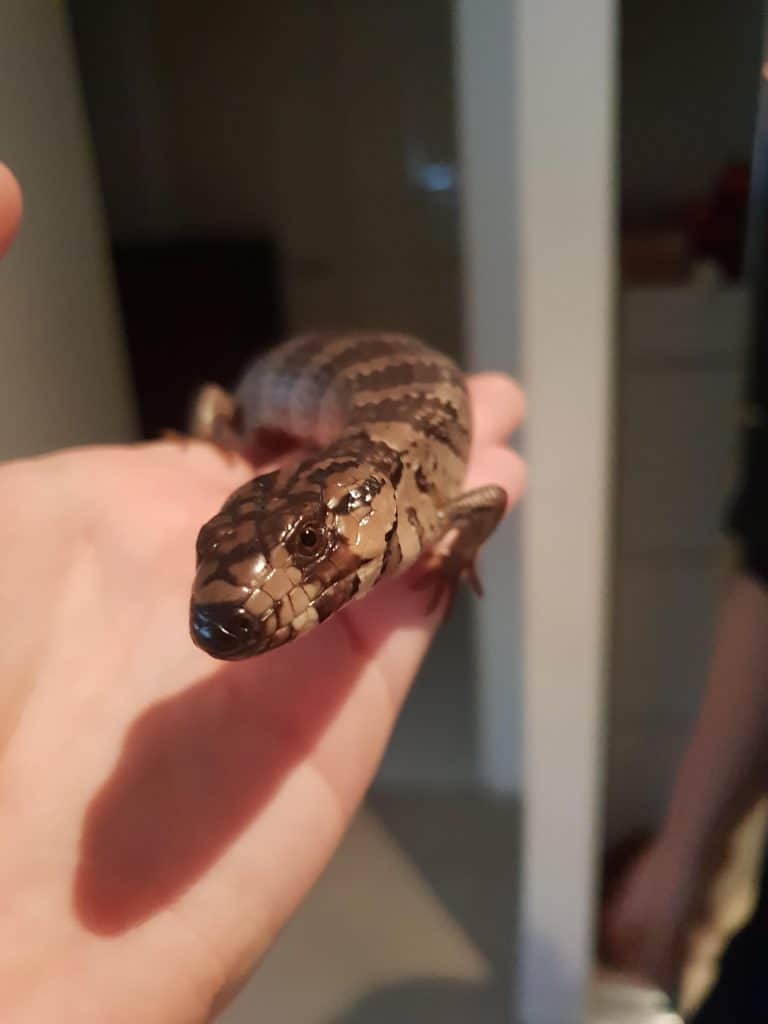
Image credit: u/Jarydeb (via Reddit.com)
These animals naturally have a lot of variation in their coloration.
Young animals have black tongues, while adults have pink tongues. The color of the bars may be brown, grey, or silver.
However, with all these variations, there are no true morphs. Morphs breed according to pattern and can be replicated with ease.
In the pink-tongued skinks, the color variations are often random, and therefore don’t qualify as morphs.
Pink-Tongued Skink Health Concerns
While these skinks aren’t prone to diseases and illnesses, some health concerns may affect them.
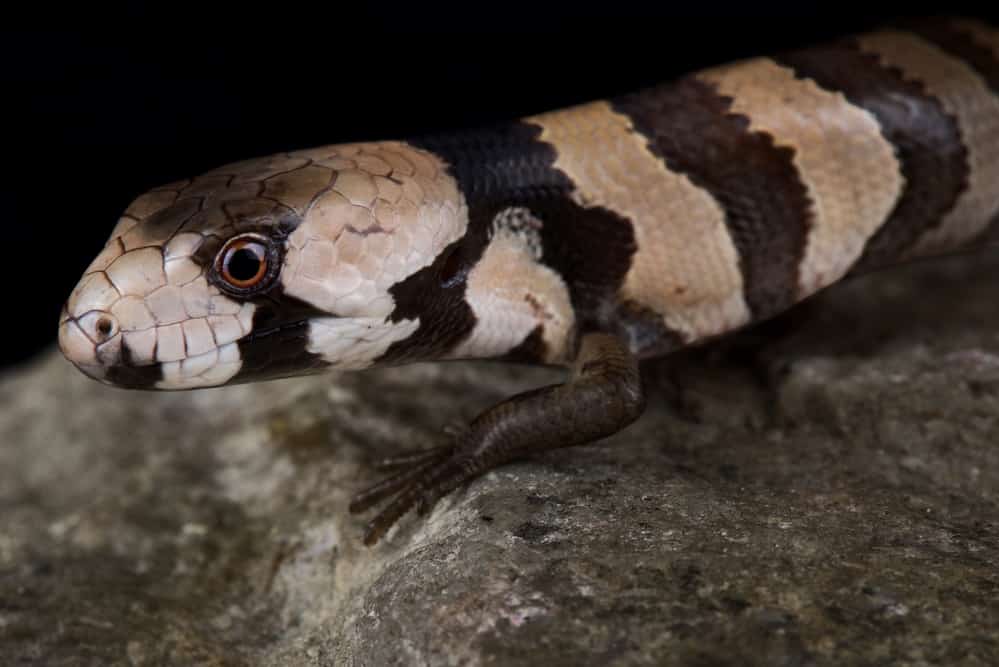
Internal and External Parasites
Parasites are a problem with almost every living species.
External parasites aren’t usually a problem in captivity, but wild skinks often suffer from them. Ticks and mites are the most common external parasites.
You’re unlikely to encounter ticks on your captive skink. If you do, grasp the tick’s body firmly and extract its head from the skink by pulling.
You can easily solve a mite problem by ordering a reptile-friendly dusting powder that kills mites if you have a mite problem.
Internal parasites include coccidia and roundworms. Wild skinks are also susceptible to other internal parasites. Symptoms of parasite infestation include:
- Lethargy
- Weight-loss
- Loss of appetite
We’d recommend having your pet lizard tested once a year so the vet can prescribe parasite treatment if needed.
Respiratory Infections
Respiratory infections are common in lizards kept at the proper humidity levels. Symptoms include:
- Lethargy
- Wheezing
- Loss of appetite
- Extra mucus in the mouth
- Discharge of mucus from the nose
If you suspect that your lizard has this kind of infection, take them to a reptile vet. You’ll need antibiotics that only a vet can prescribe.
This problem often occurs in conjunction with mouth rot and may result from stress and a weakened immune system.
Scale Rot
Scale rot is the common name for dermatitis and bacterial infections that affect a reptile’s scales.
Causes of scale rot include:
- Damaged scales
- Unclean enclosures
- Incorrect humidity levels
- Incorrect temperature ranges
If you meet the lizard’s general needs and treat any injuries immediately, then this is unlikely to be a problem for you.
However, if left untreated, scale rot can turn into fatal blood poisoning.
Scale rot presents as:
- Blisters
- Discoloration
- Raised scales
If you suspect that your lizard has scale rot, get it to a vet right away. Your vet will prescribe antibiotics and perhaps a topical treatment.
We hope you’ve enjoyed this article about pink-tongued skinks. You might also enjoy similar articles, like our monkey-tailed skink care sheet.
Blue-tailed skinks are another fascinating skink species often kept in captivity. Do you have a pink-tailed skink, or have you had skinks in the past? Let us know in the comments.
